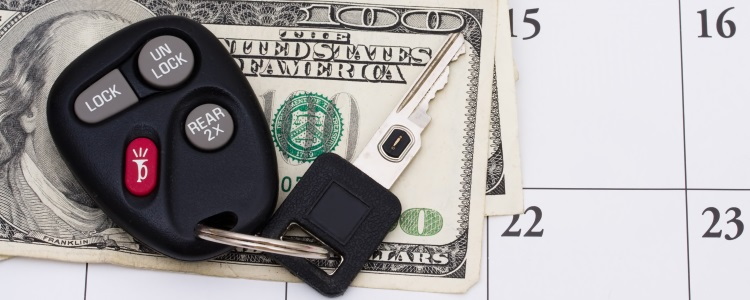The average monthly car payment is rising. In 2023, the average monthly payment on a new vehicle was $725, which is up a $125 a month compared to 2022. As the average monthly payment amount is expected to continue to increase, the average loan term is also getting longer. If you need an auto loan and have been asking yourself “What should I be paying each month on my car loan?” know that there’s no set answer to this. Many different factors affect your monthly payment amount, and it’s important to know what they are.
What Factors Determine Your Monthly Payment?
According to Experian, the average car payment is increasing due to rising car prices and consumers preferring more expensive SUVs and trucks. In the first quarter of 2023, the average monthly payment for new cars was $725 and $516 for used cars. Even though monthly payments are increasing, you can still put together a good budget.
Requirements for auto financing vary by lender, and different factors affect how much you’ll pay each month. If you’re dealing with poor credit, you’ll typically need financing through a subprime lender. Besides your credit score, there are five other things that go into determining a monthly payment:
Income
Most lenders want you to earn at least $1,500 a month before taxes, and they’ll base your ability to pay by calculating your monthly bills compared to your income (called the debt to income ratio) and your expected car payment compared to your monthly bills (called the payment to income ratio). Ideally, you’ll want a debt-to-income ratio below 50% (including your car payment and insurance) and a payment-to-income ratio of no more than 15% to 20%.

Vehicle Price
Newer cars will generally cost more than used or pre-owned versions of the same model – even though the loan term may be longer and the interest rate lower. However, new cars aren't costing too much more than some used models right now. Both new and used prices have been on the rise over the past several years.
Loan Term
The longer the loan term, the lower the monthly payment. However, a longer loan term increases your total cost because you end up paying more in interest charges. Longer loans also put you at risk of being upside down for a longer period of time. The length of your loan is also a deciding factor that determines your monthly payment. The longer your loan, the lower your monthly payment – but the trade-off is that this increases the total cost due to increased interest charges. For example, if you took out a $12,000 car loan with a 14% interest rate for 48 months, you would be paying $327 a month and $15,740 total with interest factored in. If you were to increase the loan term to 72 months, your monthly payment would drop to $247 but your total cost jumps to $17,803. It's recommended you keep your loan term as short as possible if you have bad credit and only qualify for a higher-than-average interest rate. If budgeting for a shorter term isn’t in the cards right now, you can take out a longer-term loan and possibly refinance in the future for a better rate once your credit has improved. At the same time, if your finances improve, you can always pay a little extra every month to reduce your interest expenses.
Down Payment
You’ll usually be required to put money down when taking out a subprime loan. Down payments have many positive effects on a loan, one of which is lowering the amount you have to finance – which lowers your total cost and monthly payment amount. The more you budget for a down payment, the less you’ll be paying monthly, because a down payment reduces the amount of the loan.
When dealing with subprime auto loans, a down payment will almost always be required. The amount varies by lender, but they typically ask for a minimum of $1,000 or 10% of the vehicle’s selling price. If you’re able to put more money down, it’s highly recommended that you do. Not only will a higher down payment partially offset the effects of depreciation, but it’ll also lower your monthly payment. For example, if you took out a $12,000 car loan with a 14% interest rate and a 60-month term and put $1,000 down, your monthly payment would be $256. If you add an additional $600 to the down payment, your monthly payment decreases to $242.
Credit Score
Your credit score affects how much you’ll be paying each month because it influences the interest rate you’re able to qualify for. For example, say you’re financing a used car for $15,000 with a 60-month loan term. If your interest rate is 14%, your monthly payment will be $349. If your interest rate is half that amount – 7% – your monthly payment drops to $297. Qualifying for a better interest rate typically requires better credit, though.
Interest Rate
When dealing with a subprime auto loan, you can expect to pay a higher interest rate. Although having a higher interest rate isn’t ideal, you may be able to refinance once your credit score has improved down the road.
Know Your Budget
Once you understand what goes into your monthly payment, it’s time to budget. There are many online tools you can use to help estimate what your monthly payment might look like. One of these is our auto loan monthly payment calculator. You’ll need to know the price of the car you want to finance, how much money you plan on putting down, your approximate interest rate, and the length of the loan.
The Bottom Line
How much you’re willing and able to spend each month on your car depends on your current financial situation, which is different for everyone. If you need a car loan but worry your credit will get in the way, let Auto Credit Express help.
We work with a nationwide network of special finance dealers that have the lending resources to work with people in many difficult situations. Fill out our free, no-obligation auto loan request form online to start the process today!


















